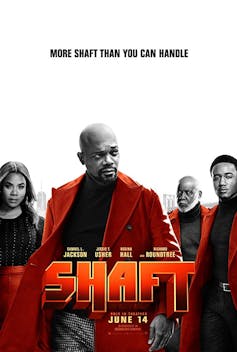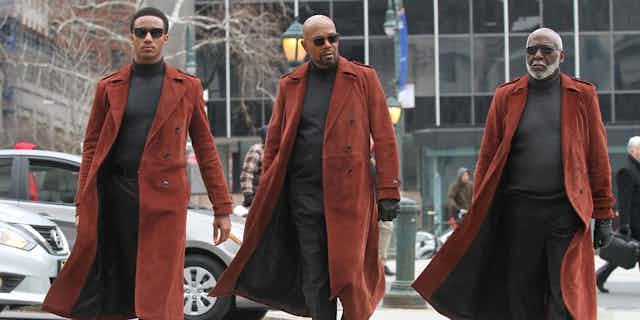John Shaft, the African American private eye introduced by Ernest Tidyman in a novel of 1970, has proved surprisingly resilient as a character on the big screen. You might have thought that Samuel L. Jackson’s second-generation Shaft in 2000 – which followed the three 1970s films – would bring closure to the franchise. But now there’s a third-generation Shaft, set in contemporary New York, which puts at the characters’ disposal computers and smartphones, rather than simply guns and Molotov cocktails.
This latest version, simply called Shaft, reflects current patterns of film exhibition, having had a brief run in US cinemas before being streamed globally by Netflix. The name “John Shaft” is, on this occasion, no one’s exclusive property, but actually shared by three of the male protagonists. Jackson appears again, but alongside two namesakes: his father (played by Richard Roundtree, who took the title role in the three films of the early 1970s) and his son (played by Jessie L. Usher and, to minimise confusion, usually referred to on screen as “JJ”).
At the start of the new film, several montages take the viewer through recent decades of African American social and cultural history. Iconic figures and events flicker briefly on screen: OJ Simpson’s trial in 1995 gives way to Barack Obama’s inauguration as US president in 2009, while an image of rapper The Notorious B.I.G. is replaced by one of basketball superstar LeBron James.
The device is principally, of course, an orientation aid for the audience, given the film’s multi-generational plotting. More profoundly, however, the sense of time passing prompts us to ask what Shaft signified for black America in the early 1970s and again in 2000 – and what he might mean in this latest incarnation.
Blaxploitation and Black Power
The first three contributions to the Shaft series belong to the period in African American cinema awkwardly, yet indelibly, labelled “Blaxploitation”. Although many Blaxploitation movies were crafted by white directors and producers, they are regarded by the film scholar Susan Hayward as representing “a positive moment in black cultural history”.
As Hayward writes: “Black audiences were given strong heroes who did not get dragged down but who actually escaped from the ghetto.” African American cinemagoers at last found stories “that both articulated their anger and gave it a positive outcome”.
Protagonists in Blaxploitation movies radically corrected the previous black imagery of submissiveness – and few screen presences were as confrontational or non-apologetic as Richard Roundtree’s Shaft. Recall his first appearance in the 1971 film. As the hi-hat cymbal pattern of Isaac Hayes’s Oscar-winning theme tune is followed by a funky guitar’s wah-wah pedal, Shaft emerges from the New York subway. Immaculately cool in long leather jacket and turtleneck sweater, he passes with utmost confidence through the city traffic.
The 1960s’ black star Sidney Poitier was, in Donald Bogle’s words, a “hero for an integrationist age”, his dignified screen image aligned with Martin Luther King. Roundtree as Shaft, by contrast, is connected in his very look to militant ideas of Black Power, albeit as heroic loner going his own way.
Shaft the man
To watch the 2000 and 2019 adaptations in light of the 1970s films, however, is to witness Shaft’s political decline. Not even the presence as director of John Singleton, nine years after his incendiary Boyz n the Hood, could save the 2000 version from lapsing into action cinema sequences stripped of social urgency. True, the plot is centred upon a racist murder – but the theme of struggling for racial justice is very hard to keep in mind among all the gunfire.

The newly released Shaft seems intent at first on critically revisiting its precursors and rejecting their model of black masculinity as outmoded. JJ is initially positioned as the opposite of his “old-school” father and grandfather – cerebral rather than physical, “anti-gun” rather than habituated to violence, and given to consensual rather than dominant relationships with women.
But sadly the film fails to sustain its investigation of alternative kinds of African American masculinity. It critiques machismo, yet ultimately reaffirms it. The geekish JJ is liberated by violence, abandoning his computer screen for guns to which he proves to be attracted after all. His aversion to fighting is soon discarded as impractical.
Shaft’s swaggering aggression, in 1971, represented a socially powerful intervention at a time when more polite expression of black demands in America seemed to be failing. But already the protagonist’s hypermasculinity was troubling.
So to reiterate the same gender coding in 2019 – a moment when Black Lives Matter has questioned the dependence of African American liberation movements on “heterosexual, cisgender men” and celebrated the contributions of “women, queer and transgender people” – seems to indicate that innovation has dried up. The evidence of this latest film suggests that, after a run of nearly 50 years, Shaft’s case files should now be closed.

